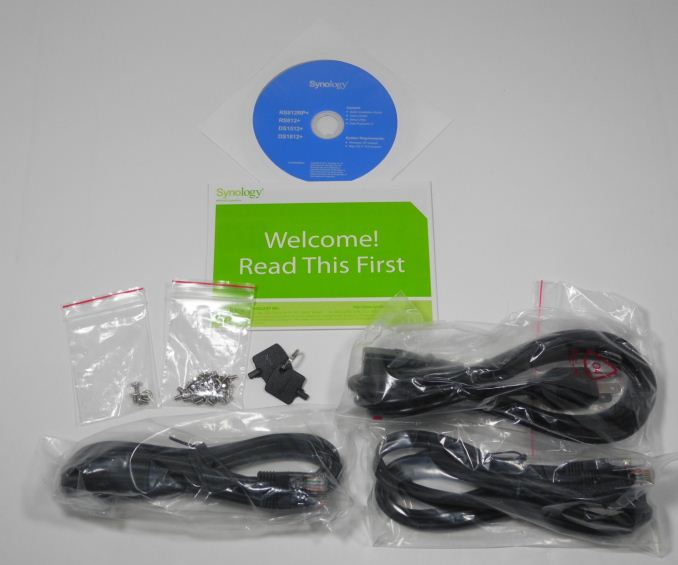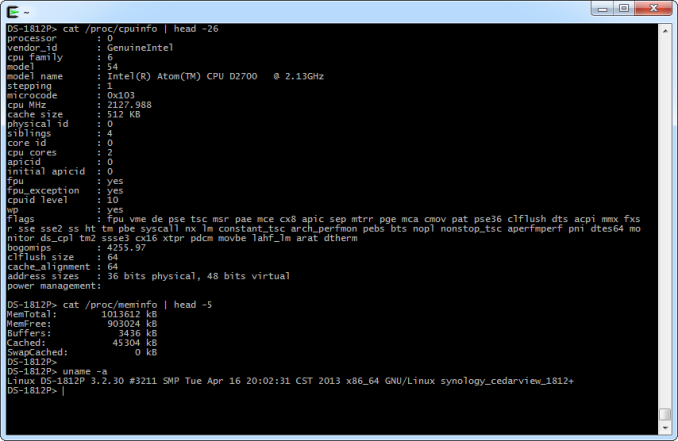Synology DS1812+ 8-bay SMB / SOHO NAS Review
by Ganesh T S on June 13, 2013 4:00 PM EST- Posted in
- NAS
- Storage
- Synology
- Enterprise
Unboxing and Setup Impressions
The Synology DS1812+ package weighs in at 14 lbs (approx. 6.3 Kgs), with the diskless unit coming in at 11.5 lbs (5.1 Kgs). The unit has a built-in PSU and has a desktop form factor with dimensions of 6.2" x 13.4" x 9.2". Along with the main unit, the package consists of the following components:
- Quick Install guide
- Software / Utilities CD
- AC power cable
- Two Cat5 cables (3ft each)
- Two keys for the hard drive bays
- Screws for mounting the hard drives to the bays
The front face of the unit has 8 vertical bays arranged side-by-side with a power button above the center. Status and alert LEDs are to the left of the power button, while the two network status indicators are to the right. On the rear side, we have two 120mm fans taking up most of the space. To the right of the fans, we have four USB 2.0 ports, one eSATA port and the two RJ-45 GbE ports. To the left, we have one more eSATA port and two USB 3.0 ports along with the the power plug receptacle. We would have like some of the ports in the front side of the chassis for easier access. The SD card slots are unfortunately relegated to the entry-level versions only and noneis available on the DS1812+ (perfectly acceptable, given the target market).
On the software side, the Disk Station Manager (DSM 4.2) is a joy to use. A lot of flexibility is provided, along with a number of interesting features. The downside is that it might be overwhelming for some consumers. SSH access is available. This provides us an avenue to get information about the unit without a full-length teardown.
Synology provides support for Disk Groups (a collection of hard drives in the NAS). Each Disk Group can be configured in either SHR (Synology Hybrid RAID - an automatic RAID management feature providing for single or dual disk failure resiliency) or with a manual RAID level. The available RAID levels for manual configuration are dependent on the number of disks in the disk group. Multiple volumes can be created in a given disk group, but users are forced to use the same RAID level for all the volumes.
An overview of the various setup options and other available features in the firmware are provided in the gallery below.























93 Comments
View All Comments
cjs150 - Friday, June 14, 2013 - link
Happy with raid 5 on a 4 bay NAS but I still watch carefully.The problem is simple. I, like most people, if buying an 8 bay NAS would buy all the disks at the same time so there is a high chance the disks are all from the same manufacture batch. So if one disk in a batch fails there is a higher chance of another failing soon after - I know because it has happened to me.
So for 8 disk NAS Raid 6 is a key feature.
That still gives me a 24TB array. Say 16-18 Gb per lossless blu-ray rip leaves room for 1200 blu rays movies (or 4000 if you are happy with some compression) and about 2000 episodes of TV epsiodes at standard definition (no compression) and maybe 3000 CDs.
That should be enough!
SirGCal - Friday, June 14, 2013 - link
My point exactly!JeffFlanagan - Friday, June 14, 2013 - link
Don't get all your drives from one source or vendor. Buy an assortment of drives for your array, and you'll be much less likely to have 2 drives fail at once.brennok - Friday, June 14, 2013 - link
I guess I am not like most people. I used SHR2 so I could fill it with various disks as I upgraded. I only started with four 1TB Reds.SirGCal - Friday, June 14, 2013 - link
But that's never enough, building my 2nd 24TB rig now actually.. :-/ But I refuse to compress my BRs. I do strip out everything but the movies, but I also do NOT pirate them. I buy them and put them on my server. No one gets them either. Being in a wheelchair, it's one of my few hobbies though so I have a LOT of movies...cjs150 - Monday, June 17, 2013 - link
Apart from the wheelchair part I do exactly as SirGCal. Using a standard Blu-ray rip (at high quality rather than original) a 2 hour movie comes in at about 15Gb file. Some are a bit larger (17Gb), some a bit smaller (13.5Gb is the smallest).That chews up a 6TB rig very quickly - particular as 6TB hard disk space is not 6TB because HD manufacturers do not quote HD space in binary but decimal units (the difference is about 7% per TB)..
I look forward to when HD come in 10TB sizes! That would be enough on my 4 bay QNAP 419+ which I consider to be an ideal consumer box - plug it in and it works
Babar Javied - Friday, June 14, 2013 - link
Can someone explain to me why this would be better than making your own NAS (with FreeNAS or something similar)? Correct me if I'm wrong but you should be able to put together a nice PC for NAS purposes for under $400 without a RAID card.... $800 (give or take) with a raid card that should be better then this no?Peroxyde - Friday, June 14, 2013 - link
Exactly! You'd even be agreeably surprise that ZFS is better than a RAID card. Additionnaly your own build server will have much more RAM. I was about to buy a QNAP 4 bays. But after spending sometimes to read more about NAS4Free, I realize that a "roll you own" NAS server beats the prebuilts on all performance factors: better case, silence, better CPU, RAM, etc. etc. There is a big inconvenience though, you need to learn NAS4Free (or FreeNAS. the commercial implementation).Case in point: my NAS server costs me less than $400 (I have the luxury to wait for quality parts to go one sale): Fractal Design R4, Corsair VX 550, 8GB G-SKill Snipper DDR 1600. Just waiting for a good mobo + AMD low power CPU and I am ready.
brennok - Friday, June 14, 2013 - link
Not necessarily better or worse. I was looking to replace my WHS and I didn't feel like doing another build. I wanted something compact, quiet, and efficient since it stays on 24/7. The Synology came highly recommended and I didn't feel like doing test builds to figure out which OS I wanted to use.SirGCal - Friday, June 14, 2013 - link
See my reply above to a few posts. I just put it up a few minutes ago... It IS better.. And quite a bit cheaper. The Synology stuff really is NOT very good for the savvy. In-fact, ESPECIALLY with this many drives, your data is at too much risk... I tried to explain it in detail. Sorry for the rather long windedness of the post but I try to be detailed.